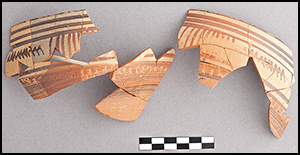Crossref Citations
This article has been cited by the following publications. This list is generated based on data provided by
Crossref.
Thomas, Hugh
2017.
A methodology for combining terrestrial and aerial photographs to create high resolution photogrammetric models of large-scale archaeological sites: A case study for Methone, Greece.
Journal of Archaeological Science: Reports,
Vol. 16,
Issue. ,
p.
27.
Noble, Gordon
Goldberg, Martin
and
Hamilton, Derek
2018.
The development of the Pictish symbol system: inscribing identity beyond the edges of Empire.
Antiquity,
Vol. 92,
Issue. 365,
p.
1329.
Papadopoulos, John K.
2018.
Greek protohistories.
World Archaeology,
Vol. 50,
Issue. 5,
p.
690.
Thomas, Hugh
2018.
Some like it hot: The impact of next generation FLIR Systems thermal cameras on archaeological thermography.
Archaeological Prospection,
Vol. 25,
Issue. 1,
p.
81.
Hodos, Tamar
2020.
The Archaeology of the Mediterranean Iron Age.
Heymans, Elon D.
2021.
The Origins of Money in the Iron Age Mediterranean World.
Boufalis, Angelos
2021.
The Encyclopedia of Ancient History.
p.
1.
van damme, Trevor
2021.
The Encyclopedia of Ancient History.
p.
1.
Boufalis, Angelos
2021.
The Encyclopedia of Ancient History.
p.
1.
Anfosso, Milena
2021.
Le phrygien, une langue balkanique perdue en Anatolie.
Dialogues d'histoire ancienne,
Vol. S 22,
Issue. Supplément22,
p.
37.
Fendel, Victoria
2021.
The missing piece in the jigsaw puzzle.
Written Language & Literacy,
Vol. 24,
Issue. 2,
p.
198.
Kotsonas, Antonis
2022.
Early Greek Alphabetic Writing: Text, Context, Material Properties, and Socialization.
American Journal of Archaeology,
Vol. 126,
Issue. 2,
p.
167.
Alagich, Rudolph
Becerra-Valdivia, Lorena
Miller, Margaret C.
Trantalidou, Katerina
and
Smith, Colin
2024.
Mediterranean Early Iron Age chronology: assessing radiocarbon dates from a stratified Geometric period deposit at Zagora (Andros), Greece.
Antiquity,
Vol. 98,
Issue. 398,
p.
454.
Parmenter, Christopher Stedman
2024.
Racialized Commodities.
